 Basics for Image Quality in Digital Imaging Systems, by Donald R. Lehmbeck This paper, the first in a series, examines some of the basic concepts of electronic and digital imaging, and it gives a framework for integrating various ways to assess image quality and their application to scanned and other electronic or printer imaging systems. The Image quality Circle showing how different classes of image quality are connected, flow diagrams of a full digital reprographic imaging system and the basic structure of digital
Basics for Image Quality in Digital Imaging Systems, by Donald R. Lehmbeck This paper, the first in a series, examines some of the basic concepts of electronic and digital imaging, and it gives a framework for integrating various ways to assess image quality and their application to scanned and other electronic or printer imaging systems. The Image quality Circle showing how different classes of image quality are connected, flow diagrams of a full digital reprographic imaging system and the basic structure of digitalimages are reviewed. Download Now (pdf)
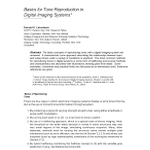 Basics for Tone Reproduction in Digital Imaging Systems, by Donald R. Lehmbeck The basic concepts of reproducing tones with a digital imaging system are reviewed. A characteristic curve approach describing the relationship between input and output tones under a variety of conditions is explored. The most common methods for reproducing tones in digital systems is some form of halftoning and several methods and characteristics are described with illustrations showing pixel level detail. Download Now (pdf)
Basics for Tone Reproduction in Digital Imaging Systems, by Donald R. Lehmbeck The basic concepts of reproducing tones with a digital imaging system are reviewed. A characteristic curve approach describing the relationship between input and output tones under a variety of conditions is explored. The most common methods for reproducing tones in digital systems is some form of halftoning and several methods and characteristics are described with illustrations showing pixel level detail. Download Now (pdf)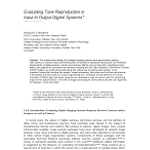 Evaluating Tone Reproduction in Input to Output Digital Systems, by Donald R. Lehmbeck The system level details of full digital imaging systems tone reproduction starting with camera or scanner input and finishing with the printed or displayed reproduction are reviewed. Responsivity of digital sensors, camera and scanner effects such as flare light, integrating cavity effect, test patterns for scanners and cameras including the ISO Opto Electronic Conversion Function (OECF) pattern are briefly discussed along with references to explore each further. Download Now (pdf)
Evaluating Tone Reproduction in Input to Output Digital Systems, by Donald R. Lehmbeck The system level details of full digital imaging systems tone reproduction starting with camera or scanner input and finishing with the printed or displayed reproduction are reviewed. Responsivity of digital sensors, camera and scanner effects such as flare light, integrating cavity effect, test patterns for scanners and cameras including the ISO Opto Electronic Conversion Function (OECF) pattern are briefly discussed along with references to explore each further. Download Now (pdf)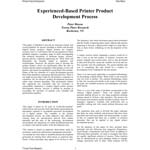 Experience-Based Printer Product Development Process, by Peter Mason This paper is intended to provide an experience-based, real world guideline for anyone intending to define and develop digital printer products in fact any product of similar complexity. It defines the significant key principles that are necessary to successfully implement a complex digital printer product development process. Success is defined as meeting or exceeding the priorities of product cost, schedule and performance (quality). Download Now (pdf)
Experience-Based Printer Product Development Process, by Peter Mason This paper is intended to provide an experience-based, real world guideline for anyone intending to define and develop digital printer products in fact any product of similar complexity. It defines the significant key principles that are necessary to successfully implement a complex digital printer product development process. Success is defined as meeting or exceeding the priorities of product cost, schedule and performance (quality). Download Now (pdf)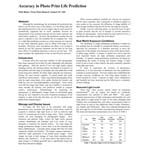 Accuracy in Photo Print Life Predictions, by Peter Mason Although the methodology for developing life predictions has been in use for some years in the industry, it is becoming clear that the implied precision in the use of a single value in years cannot be scientifically supported due to much variability between the measurement of an assumed exposure and the actual exposure and observation conditions. All print life predictions assume that the print is exposed to only one condition for its complete life. That is, a light fade prediction assumes no ozone exposure (or exposure to any other industrial gases), and no effects from high or low humidity. This paper examines the implications of this on real life print exposure. Download Now (pdf)
Accuracy in Photo Print Life Predictions, by Peter Mason Although the methodology for developing life predictions has been in use for some years in the industry, it is becoming clear that the implied precision in the use of a single value in years cannot be scientifically supported due to much variability between the measurement of an assumed exposure and the actual exposure and observation conditions. All print life predictions assume that the print is exposed to only one condition for its complete life. That is, a light fade prediction assumes no ozone exposure (or exposure to any other industrial gases), and no effects from high or low humidity. This paper examines the implications of this on real life print exposure. Download Now (pdf)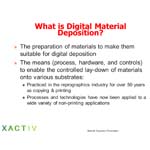 DIGITAL Material Deposition for Product Manufacturing Processes, by Peter Mason This detailed PowerPoint presentation begins with a summary of the last fifty years of digital printing technology and focuses in on contemporary applications of digital deposition of liquids, powders, and dry-film materials. Subjects covered include electrophotography, iconography, electrography, and magnetography. Drop-on-demand and continuous ink-jet, thermal transfer, and toner-jet methods are outlined in addition to other popular techniques. Special emphasis is placed on the ink-jet and electrostatic powder deposition methods and a host of related real-world applications are shown. Download Now (PowerPoint)
DIGITAL Material Deposition for Product Manufacturing Processes, by Peter Mason This detailed PowerPoint presentation begins with a summary of the last fifty years of digital printing technology and focuses in on contemporary applications of digital deposition of liquids, powders, and dry-film materials. Subjects covered include electrophotography, iconography, electrography, and magnetography. Drop-on-demand and continuous ink-jet, thermal transfer, and toner-jet methods are outlined in addition to other popular techniques. Special emphasis is placed on the ink-jet and electrostatic powder deposition methods and a host of related real-world applications are shown. Download Now (PowerPoint) The Technology of Color Laser Printing, by Peter Mason The technology that makes laser printers work finds its beginnings back to the first xerographic copiers produced more than sixty years ago. The inventor was a patent attorney named Chester Carlson who collaborated with engineers at the Battelle Memorial Institute in 1944 to define the feasibility of the first copier and later formed a small Rochester company named Haloid to capitalize on the idea. This detailed paper describes the basic principles, subsystems, and engineering sensitivities of color laser printers. Download Now (pdf)
The Technology of Color Laser Printing, by Peter Mason The technology that makes laser printers work finds its beginnings back to the first xerographic copiers produced more than sixty years ago. The inventor was a patent attorney named Chester Carlson who collaborated with engineers at the Battelle Memorial Institute in 1944 to define the feasibility of the first copier and later formed a small Rochester company named Haloid to capitalize on the idea. This detailed paper describes the basic principles, subsystems, and engineering sensitivities of color laser printers. Download Now (pdf)